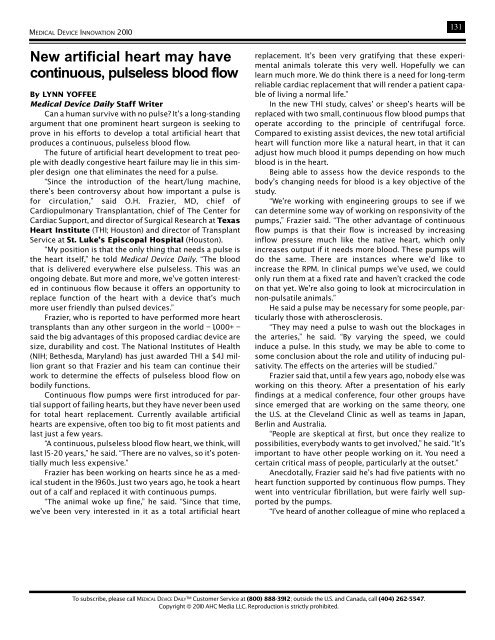MEDICAL DEVICE INNOVATION - Medical Device Daily
MEDICAL DEVICE INNOVATION - Medical Device Daily
MEDICAL DEVICE INNOVATION - Medical Device Daily
Create successful ePaper yourself
Turn your PDF publications into a flip-book with our unique Google optimized e-Paper software.
<strong>MEDICAL</strong> <strong>DEVICE</strong> <strong>INNOVATION</strong> 2010<br />
New artificial heart may have<br />
continuous, pulseless blood flow<br />
By LYNN YOFFEE<br />
<strong>Medical</strong> <strong>Device</strong> <strong>Daily</strong> Staff Writer<br />
Can a human survive with no pulse It’s a long-standing<br />
argument that one prominent heart surgeon is seeking to<br />
prove in his efforts to develop a total artificial heart that<br />
produces a continuous, pulseless blood flow.<br />
The future of artificial heart development to treat people<br />
with deadly congestive heart failure may lie in this simpler<br />
design one that eliminates the need for a pulse.<br />
“Since the introduction of the heart/lung machine,<br />
there’s been controversy about how important a pulse is<br />
for circulation,” said O.H. Frazier, MD, chief of<br />
Cardiopulmonary Transplantation, chief of The Center for<br />
Cardiac Support, and director of Surgical Research at Texas<br />
Heart Institute (THI; Houston) and director of Transplant<br />
Service at St. Luke’s Episcopal Hospital (Houston).<br />
“My position is that the only thing that needs a pulse is<br />
the heart itself,” he told <strong>Medical</strong> <strong>Device</strong> <strong>Daily</strong>. “The blood<br />
that is delivered everywhere else pulseless. This was an<br />
ongoing debate. But more and more, we’ve gotten interested<br />
in continuous flow because it offers an opportunity to<br />
replace function of the heart with a device that’s much<br />
more user friendly than pulsed devices.”<br />
Frazier, who is reported to have performed more heart<br />
transplants than any other surgeon in the world – 1,000+ –<br />
said the big advantages of this proposed cardiac device are<br />
size, durability and cost. The National Institutes of Health<br />
(NIH; Bethesda, Maryland) has just awarded THI a $4.1 million<br />
grant so that Frazier and his team can continue their<br />
work to determine the effects of pulseless blood flow on<br />
bodily functions.<br />
Continuous flow pumps were first introduced for partial<br />
support of failing hearts, but they have never been used<br />
for total heart replacement. Currently available artificial<br />
hearts are expensive, often too big to fit most patients and<br />
last just a few years.<br />
“A continuous, pulseless blood flow heart, we think, will<br />
last 15-20 years,” he said. “There are no valves, so it’s potentially<br />
much less expensive.”<br />
Frazier has been working on hearts since he as a medical<br />
student in the 1960s. Just two years ago, he took a heart<br />
out of a calf and replaced it with continuous pumps.<br />
“The animal woke up fine,” he said. “Since that time,<br />
we’ve been very interested in it as a total artificial heart<br />
131<br />
replacement. It’s been very gratifying that these experimental<br />
animals tolerate this very well. Hopefully we can<br />
learn much more. We do think there is a need for long-term<br />
reliable cardiac replacement that will render a patient capable<br />
of living a normal life.”<br />
In the new THI study, calves’ or sheep’s hearts will be<br />
replaced with two small, continuous flow blood pumps that<br />
operate according to the principle of centrifugal force.<br />
Compared to existing assist devices, the new total artificial<br />
heart will function more like a natural heart, in that it can<br />
adjust how much blood it pumps depending on how much<br />
blood is in the heart.<br />
Being able to assess how the device responds to the<br />
body’s changing needs for blood is a key objective of the<br />
study.<br />
“We’re working with engineering groups to see if we<br />
can determine some way of working on responsivity of the<br />
pumps,” Frazier said. “The other advantage of continuous<br />
flow pumps is that their flow is increased by increasing<br />
inflow pressure much like the native heart, which only<br />
increases output if it needs more blood. These pumps will<br />
do the same. There are instances where we’d like to<br />
increase the RPM. In clinical pumps we’ve used, we could<br />
only run them at a fixed rate and haven’t cracked the code<br />
on that yet. We’re also going to look at microcirculation in<br />
non-pulsatile animals.”<br />
He said a pulse may be necessary for some people, particularly<br />
those with atherosclerosis.<br />
“They may need a pulse to wash out the blockages in<br />
the arteries,” he said. “By varying the speed, we could<br />
induce a pulse. In this study, we may be able to come to<br />
some conclusion about the role and utility of inducing pulsativity.<br />
The effects on the arteries will be studied.”<br />
Frazier said that, until a few years ago, nobody else was<br />
working on this theory. After a presentation of his early<br />
findings at a medical conference, four other groups have<br />
since emerged that are working on the same theory, one<br />
the U.S. at the Cleveland Clinic as well as teams in Japan,<br />
Berlin and Australia.<br />
“People are skeptical at first, but once they realize to<br />
possibilities, everybody wants to get involved,” he said. “It’s<br />
important to have other people working on it. You need a<br />
certain critical mass of people, particularly at the outset.”<br />
Anecdotally, Frazier said he’s had five patients with no<br />
heart function supported by continuous flow pumps. They<br />
went into ventricular fibrillation, but were fairly well supported<br />
by the pumps.<br />
“I’ve heard of another colleague of mine who replaced a<br />
To subscribe, please call <strong>MEDICAL</strong> <strong>DEVICE</strong> DAILY Customer Service at (800) 888-3912; outside the U.S. and Canada, call (404) 262-5547.<br />
Copyright © 2010 AHC Media LLC. Reproduction is strictly prohibited.
















